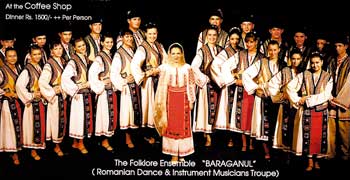
Romanian Folklore Fest at GaladariFolklore ensemble 'Baraganul' ranked by the folklore specialists to be the most representative folklore ensemble in Calarasi County, and one of the best in Romania will come alive at the Coffee Shop of the Galadari Hotel on November 30. ‘Baraganul', food and folklore festival, consists of a group of young people, pupils and students, who have understood that the spiritual identity of a people lies within its traditional culture. The ensemble was founded in 1993 by Calarasi County Council and belongs to the County Centre for Preservation and Promotion of Traditional Culture.
All successes gained by these young people on the scenes all over the country and abroad in national and international festivals (in France, Japan, Italy, USA, Greece, Turkey, Bulgaria and other countries) have made that the message of Romanian spirituality to be passed on through songs and dances of an untamed beauty and of a great artistic and documentary value. Their repertoire consists of folk dances from all folklore areas of Romania: Muntenia, Oltenia, Dobrogea, Moldova and Transylvania.‘Hora’ (the round dance), 'Floricica' (the little flower), ‘Sarba’, ‘Mocancutza’, ‘Brau’ (the belt) and ‘Dogoreanca’ are folklore dances specific to the plain area of Mounteniaand all of them impress especially by vitality and vigour. These dances are run mostly in closed circles, and very few are mixed (boys and girls together, such as "the belts", with holding hands or shoulders, with a vigorous tempo, the few figures (one or two figures for each dance). The dances from Dobroges, with different rhythms, mixed and composed measures are not to be found in other areas, with very few exceptions, such as "Poparlanul", which could be met also in Muntenia. "Geamparalele" is a dance characteristic (and always found) to a family event - the wedding. The rhythm is relatively simple and the steps easily to be kept in mind and executed. The rhythms of Dobrogea are very specific to Balkans registry. The dances of Oltenia are generally "run" to the right or to the left, with fast and short movements of legs and many arms movements ; in the same time, they are full of joy and natural ease with often changing accents, containing loud shouts commending the change of general movement. Transilvania is an ethnographic area in which the clap of the hands on the legs is very specific. Men dances in force do reflect the vigour of the Transilvanian man. Women dances reflect the same. We also encounter the dances in pairs and the spinning of the girls under the arm - pirouettes. The rhythms of the dances are from slow (such as "purtatele") to very fast (such as "hatzeganele"). ‘Baraganul' performances is to celebrate the National Day of Romania and the 50th Anniversary of Diplomatic Relations between Romania and Sri Lanka. The tickets are prices at Rs. 1500++ per head inclusive of dinner. Calarasi Country is located in the South-East of Romania, on Borcea branch of Danube River, between Bucharest and Constanta ; the area has a peculiar specific within traditional Romanian culture. The folklore ensemble <<Baraganul>>, with youth, pupils and students, has been founded in 1993 by the County Council of Calarasi and belongs to the County Centre for Preservation and promotion of Traditional Culture. Each summer this institution organize in Calarasi, under CIOFF, the biggest international folklore festival within Lower Danube Euro-Region, called "Hora Mare" (meaning " The Big Round Dance"). Because of the quality of performance and the authenticity of its repertoire, "Baraganul" ensemble have gained unanimous appreciations both at national and international level (in France, Japan, Italy, USA, Greece, Turkey, Bulgaria and other countries). This ensemble promote firstly the folklore characteristic to Calarasi area, and also the beauty of the folk songs, dances and costumes form almost all over Romania. The authenticity of choreographic repertoire is given by the fact that all dances, gathered from villages, are set up on the stage in such a manner that keeps within the style specific to the rural environment. The circle is often found within the choreographic design - an element of composition characteristic to Romanian folklore, and especially to Southern realms. A separate note is the alternation of slow and very dynamic rhythms during the same dance, which contributes to the spectacular performances given by "Baraganul" folklore ensemble. |
|| Front
Page | News | Editorial | Columns | Sports | Plus | Financial
Times | International | Mirror | TV
Times | Funday
Times || |
| |
Reproduction of articles permitted when used without any alterations to contents and the source. |
© Copyright
2007 | Wijeya
Newspapers Ltd.Colombo. Sri Lanka. All Rights Reserved. |
